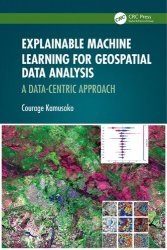 Название: Explainable Machine Learning for Geospatial Data Analysis: A Data-Centric Approach
Название: Explainable Machine Learning for Geospatial Data Analysis: A Data-Centric ApproachАвтор: Courage Kamusoko
Издательство: CRC Press
Год: 2025
Страниц: 280
Язык: английский
Формат: pdf (true), epub
Размер: 44.9 MB
Explainable Machine Learning (XML), a subfield of Artificial Intelligence (AI), is focused on making complex AI models understandable to humans. This book highlights and explains the details of Machine Learning models used in geospatial data analysis. It demonstrates the need for a data-centric, explainable Machine Learning approach to obtain new insights from geospatial data. It presents the opportunities, challenges, and gaps in the Machine Learning and Deep Learning approaches for geospatial data analysis and how they are applied to solve various environmental problems in land cover changes and in modeling forest canopy height and aboveground biomass density. The author also includes guidelines and code scripts (R, Python) valuable for practical readers.
This book is divided into three parts and ten chapters. Part I introduces explainable machine learning (ML), Part II covers the foundations of explainable ML, and Part III focuses on techniques and applications.
Chapter 1 introduces machine learning for geospatial data analysis and is divided into four sections. Section 1.1 presents a brief introduction to Machine Learning for geospatial data analysis. Section 1.2 focuses on model and data-centric Explainable Machine Learning. Section 1.3 describes the primary datasets and case studies used in the book. Finally, Section 1.4 provides the concluding remarks.
Chapter 2 covers the basic concepts of explainable machine learning. Section 2.1 provides a brief background on explainable machine learning. Section 2.2 discusses interpretability and explainability, while Section 2.3 focuses on the types of explainable machine learning for opaque (black box) models. Finally, Section 2.4 provides the summary and concluding remarks.
Chapter 3 focuses on the approaches to explainable machine learning. Section 3.1 provides a brief introduction to machine learning. Next, Section 3.2 covers supervised machine learning methods, such as logistic regression, support vector machines (SVM), decision trees, random forests, and histogram-based gradient boosting (HGB).
Chapter 4 provides an overview of explainable deep learning. Section 4.1 briefly introduces explainable deep learning and gives a brief historical development of deep learning. Next, Section 4.2 provides an overview of deep learning architecture, such as convolutional neural networks (CNNs).
...
The final Chapter 10 provides an overall summary of data-centric explainable machine learning. Section 10.1 presents an overview of advancing explainable artificial intelligence (AI) for geospatial data analysis with a data-centric approach. Section 10.2 discusses the progress in explainable AI for improved geospatial data analysis.
Features:
Data-centric explainable machine learning (ML) approaches for geospatial data analysis.
The foundations and approaches to explainable ML and deep learning.
Several case studies from urban land cover and forestry where existing explainable machine learning methods are applied.
Descriptions of the opportunities, challenges, and gaps in data-centric explainable ML approaches for geospatial data analysis.
Scripts in R and Python to perform geospatial data analysis, available upon request.
This book is an essential resource for graduate students, researchers, and academics working in and studying data science and machine learning, as well as geospatial data science professionals using GIS and remote sensing in environmental fields.
Скачать Explainable Machine Learning for Geospatial Data Analysis: A Data-Centric Approach
[related-news] [/related-news]
Комментарии 0
Комментариев пока нет. Стань первым!















